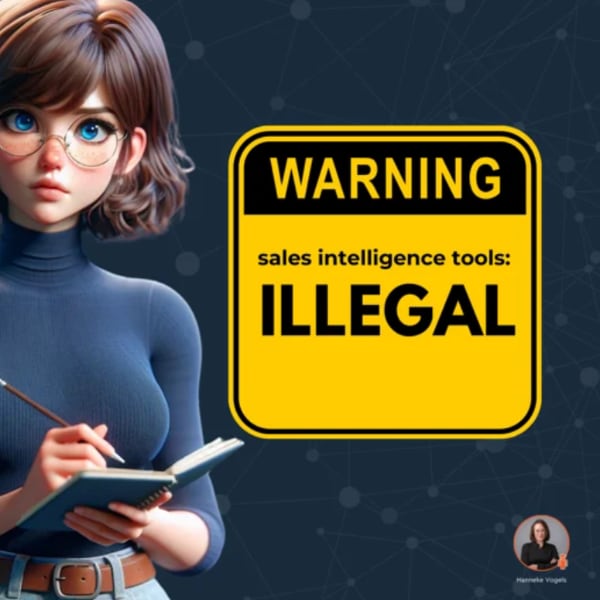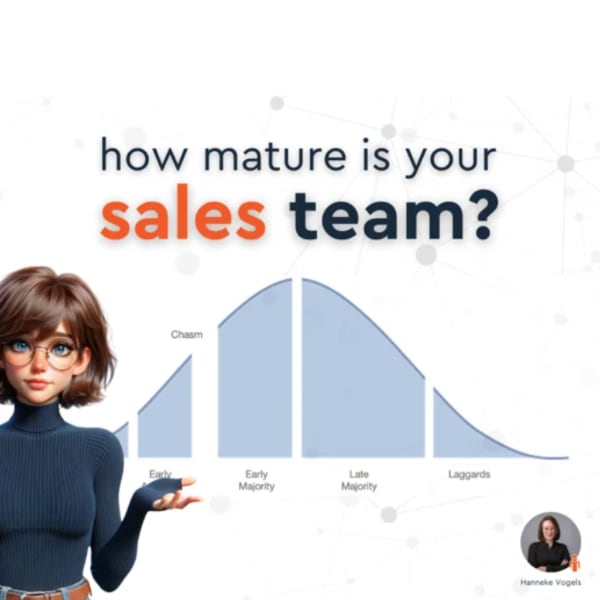20+ ways to elevate conversion rates
Hi,
I bet you want every lead to turn into a customer. Sadly, that’s never going to happen. Yet, you do strive for it, right? So, enhancing the conversion rates within your sales is a serious topic. That’s why this sales tech update is all about the impact you can make on your conversion rates.
Conversion ratios are usually only measured at two parts of the funnel:
- From Marketing Qualified Lead (MQL) to Sales Qualified Lead (SQL) and
- From SQL to deal
But I’d like you to dig a little deeper into your CRM data and divide your sales ratios into some more:
- From MQL to SQL
- From the first call to an opportunity
- From meeting to proposal
- From proposal to deal
Per phase, I’ll give you some benchmarks based on my practical experience in B2B and how to enhance it with tech.
From MQL to SQL
Knowing that only 3% of the market is buying right now, you’d think that going for 3 to 5% is a good conversion rate. However, this means your marketing efforts are focused on a too-big group. Ideally, you’d want to have a conversion rate of around 20% at least, but better would be 30%.
To enhance your conversion rates, you’d need to dive into the marketing ops of your commercial team. Yes, positioning, branding, and such matter, but to get better conversion rates from MQL to SQL, your focus should be on creating repetitive multi-touch campaigns for specific target groups. Those target groups should be small and homogeneous. Most marketing teams produce content, but their production is more about the creative side and not about repetitive work. You need a machine where you can reuse channels, visuals, and content and simply alter it per target group. You can automate this to a pretty high standard with a combination of martech and have it based on your sales platform (AKA CRM).
From the first call to an opportunity
If you want to convert as many calls as possible into opportunities, there are many things you can do. First of all, your benchmark stat here is 40%. It seems high, but I encourage you not to look at SQLs that are not in the market now but to look at them over time. As stated in the previous paragraph, not everyone is buying now. You’d want to look over a longer period of time.
There are many ways to upgrade your conversion rate, but these three have the biggest impact.
- Enforce call preps. I know auto-dialers are a thing, but they absolutely kill preparation time. And that prep is key. Data enrichment gives all the data an SDR needs to do a call, and you might even want to throw in a personality indexer, like Crystal Knows, to have the rep speak in the right tone. You want to go for a highly standardized process that is brutally enforced.
- Automate follow-up outreaches based on the call outcome. That means that the SDR needs to give an outcome of the call: interested now, interested in 6 months, interested later, or unqualified. The outcome should trigger the follow-up call task, leaving no lead in the twilight. These automations are easy to build within most CRMs with automation features, or you can use Zapier or Make to automate them.
- Create a flow that does some social media interaction a day or two before the call. This ensures the name of the rep and your company is already known. It can be as simple as profile visits, likes, and comments. You can fully automate it, but I recommend you at least keep the real interaction-like comments to be human (thus manual). Tools like Expandi, BreakCold, and HubLead, in combination with your CRM, are key to automating steps in this process. Have your CRM trigger these through, again, automated workflows.
From meeting to proposal
This part is mostly human, as in B2B sales, you really want to get close to a potential customer. If your first two steps are done right, your conversion rate here should be around 50% at least, but depending on your services, your product’s market fit, and the market demand for it, it can be as high as 90%.
To upgrade your conversion to proposals, you want to support the salesperson as much as you can. We always think that getting at the table is the hardest part of sales, but in my experience, this is where most potential deals are ruined.
- First off, your meeting preparation should be thorough. The only way to do that is through prep tasks. You can diversify the tasks based on the meeting sort. Again, these things can be easily done with automation within your CRM.
- The next step is to create a Conversational Intelligence log, transcribe the meetings, and summarize them. Many tools are on the market, and by now, most can do that in many languages.
- Deal health scores can go even further and enhance control over your opportunities, working as indicators of the amount of control over a deal. These scores work pretty much the same as lead scoring, where input is scored and presented as a total. It starts to get boring, but your CRM should be able to do that. No extra tool is needed for it.
From proposal to deal
In B2B sales, you should go for a 90% conversion rate on this part of the funnel. All the hard work and the uncertainties are in the first part, where you are still uncovering the true match. Once you write a proposal, you want it to be a done deal.
My tips to upgrade your conversion rates are pretty straightforward:
- Have strict rules for when a proposal can be sent. That is something you can rule over with the use of simple questions in your opportunities within CRM. If the right level is not met, the deal cannot move forward, helping salespeople to keep control over their deal.
- As a client of mine once said: I want a proposal to feel like a present. And that, my friend, cannot be reached with a PowerPoint or Word document. You need a proposal tool that is engaging and filled with info the clients want to have. I recommend Better Proposals or PandaDoc. There are many more in the proposal tool section and I additionally recommend hiring a designer to create visuals and an appealing setup.
- Don’t forget the automated follow-up after a signed deal, where you can even put a little thank you video in, that you can even personalize with AI. In this follow-up, you tell your new customer what the next steps are and what to expect from your company. Easy to arrange and has a huge impact on the customer journey.
Knowing all this, your next step is to identify where in your sales process the biggest gap with the benchmark is. It’s time to upgrade!
If you need help with it, you know where to find us.
Interesting posts you might’ve missed
These are the posts I published on LinkedIn that are worth checking out:
A good measure
To see where you are at. All that talking about Sales Tech makes you wonder where you are with your endeavors. That’s why I created a simple explanation based on the Chasm Model. Have a look at it.
Many highs this month
I always love to leave you with a personal note about something that stood out for me. This month has been wild. We started with a bang, as my book Sales Tech – Building the Ultimate Sales Machine came out in English. It’s available on Amazon.
Next, we are broadening and deepening our services with Marketing Ops and adding Bid Management expertise to our team. The first is because we see that many of our clients need a better alignment between Marketing and Sales and want their marketing efforts to be more efficient. The second is one of my personal favorite parts of the sales process. Bid Management is a highly complex and competitive field. With the additional expertise on this, we can help even more clients to speed up.
I also had my first-ever viral post on LinkedIn. The virality of it wasn’t my highlight, but the fact that sales tech in general is in the spotlight and so many people want to have something to say about it.
Lastly, I guess it’s event month because I did seven keynotes in three weeks. Sales Tech is on the agenda, and I’ve met hundreds of people during these events. I deeply believe Sales Tech is the key ingredient for bringing B2B Sales to the next level, and I could not be happier. So I’ll leave you with that.

About Sales Tech, but not technical
Subscribe now and receive the best insights into successfully applying sales technology to your sales team. The Sales Tech Update lands in your mailbox every four weeks.



